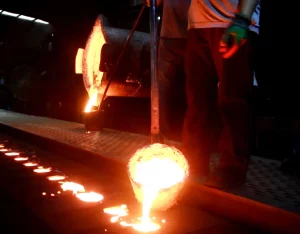Lost foam casting components are an essential part of the casting process. They are used to create molds that are used to cast metal parts. These components are designed to be used once and then discarded, hence the name “expendable.” They are made from materials that can withstand the high temperatures and pressures of the casting process, such as sand, ceramic, and wax.
Lost foam casting (also known as full mold casting) is a new casting method that combines paraffin wax or foam models similar to the size and shape of castings into model clusters, brushes and dries fire-resistant coatings, buries them in dry quartz sand for vibration molding, pours them under negative pressure, vaporizes the model, occupies the position of the model with liquid metal, and forms castings after solidification and cooling.
Sand casting components are the most widely used type of expendable casting components. They are made from a mixture of sand, clay, and water, which is packed around a pattern to create a mold. The mold is then filled with molten metal, which solidifies and takes the shape of the mold.
Sand casting components are ideal for creating large, heavy parts, such as engine blocks and transmission cases. They are also used to create parts with complex shapes and designs, such as turbine blades and impellers.
The process of lost foam casting is as follows:
Produce a foam plastic white mold, combine the pouring system, brush and spray a special high-temperature resistant coating on the surface of the gasification mold, and dry it.
Place the specially designed interlayer sand box on a vibration workbench, fill it with bottom sand (dry sand), compact it, and scrape it flat. Place the dried gasification mold on the bottom sand, fill it with dry sand, and gently vibrate to scrape the box mouth at an appropriate time.
Cover with plastic film, place a pouring cup, connect to the vacuum system for vacuum suction, and after the dry sand is firmly formed, pour. The white mold vaporizes and disappears, and the metal liquid replaces its position.
Release the vacuum, wait for the casting to condense, then flip the box and remove the casting from the loose dry sand.
The advantages of lost foam casting are as follows:
The casting has precise size and shape, good repeatability, and has the characteristics of precision casting.
The sand core and core making departments have been abolished, and casting defects and waste products caused by core making and core laying have been eradicated.
Not matching the box and not taking the mold greatly simplifies the molding process, eliminating casting defects and scrap caused by taking the mold and closing the box.
The use of dry sand molding without binder, moisture, and any additives eliminates various casting defects and waste products caused by moisture, additives, and binders.
The sand treatment system has been greatly simplified, and the molding sand can be fully reused, eliminating the molding sand preparation and waste sand treatment departments.
The characteristics and advantages of lost foam casting are as follows:
1.The casting has good quality and low cost.
2.No material limit, suitable size.
3.The size is accurate.
4.High precision, smooth surface, reducing cleaning.
5.External defects are greatly reduced and the organization is dense.
6.Can achieve large-scale and mass production. Fully automatic assembly line is environmentally friendly.
7.Compared with ordinary casting, It can greatly improve the operating environment, reduce labor intensity, and reduce energy consumption.
Sepecially for the process of samples,Only foam mold can make casting then get samples and avoid high cost of metal mold directlt.For the small quantity order,its also workable and better choice for customers.













-3-300x249.png)

